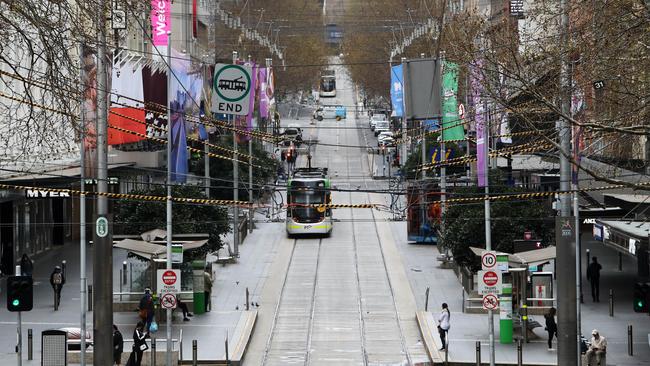Coronavirus: Victoria facing a $6bn hit and an extra 350,000 workers joining jobless queues
Victoria’s economy will shrink by up to 20 per cent with new modelling showing the virus hit could be as much as $6bn.

Victoria’s economy will shrink by up to 20 per cent on pre-pandemic levels because of its extended restrictions and business shutdowns, with new modelling showing the hit to the state in the September quarter could be as much as $6bn.
As Victorian business owners stay closed for longer, an increasing number will fold, according to a KPMG analysis which — in its worst-case scenario — forecasts an extra 350,000 workers could join the jobless queue in the three months to September.
This would be on top of the roughly 250,000 jobs already lost as a result of the COVID-19 crisis, and lower the number of employed Victorians to 2.85 million by September, down from about 3.45 million in March.
The projections come as Victorian Premier Daniel Andrews prepares to unveil a major economic rescue package in coming days, following the weekend announcement of a two-week extension to Melbourne’s lockdown.
KPMG chief economist Brendan Rynne told The Australian the second wave of new infections had “compounded” the damage from the national shutdowns in April and May, even as other states and territories began their recoveries. “The likelihood is the downturn in economic activity in Victoria is going to negate the upturn elsewhere in the country, which will put the September quarterly result at virtually zero growth,” Dr Rynne said.
“Based on the Victorian roadmap, it would seem this trajectory will continue into October.”
The Morrison government held a meeting of cabinet’s expenditure review committee on Tuesday in which the impacts of the Victorian government’s roadmap were discussed.
The final meeting of the razor gang before the October 6 budget will be held this week.
The continued lockdown in Victoria — which may not see the bulk of Victorian businesses start to reopen until at least October and for many more as late as November — could see another $6bn to $8bn wiped off the national economy. This would be on top of the $10bn to $12bn already estimated by Treasury from the staged lockdowns through the September quarter.
Richard Goyder, the chair of Qantas, Woodside and the AFL Commission, told The Australian political leaders needed to be more transparent over the use of medical advice to justify economy-wide restrictions.
The former chief executive of Wesfarmers said the trade-off between the health and economic outcomes was “not balanced” and “out of whack”, and people wanted a “sensible and realistic” roadmap to recovery.
“It would be useful to understand the medical advice that governments are receiving and the context in which that advice has been asked for,” he said.
“Is the medical advice being asked for about how do we manage this with zero risk? Or is it, how do we manage this with a relative risk related to the economic consequences? Or how does that flow into decision-making?
“A number of political leaders are standing behind medical advice but don’t seem to be factoring in economic outcomes, mental health and family issues with the same degree of importance.”
The Morrison government on Tuesday had still not received the full modelling behind Mr Andrews’s recovery roadmap, with business groups demanding to see the assumptions after accusing the Victorian government of failing to consult with them properly.
In August, Treasury forecast the initial Victorian stage-three restrictions would see a $3.3bn hit to GDP in the September quarter.
This was revised up to $10bn to $12bn when stage-four restrictions were announced, with the Victorian measures forecast to cut 2.5 percentage points from quarterly real GDP growth.
The weekly cost to the national economy is now estimated to be running at $1bn a week, according to Treasury sources. This could see the total economic damage from Victorian lockdowns reach $20bn by the end of the year.
Dr Rynne said KPMG’s worst-case scenario of 350,000 job losses in the three months to September was “plausible”, and one that increased in likelihood with each delay to the state’s reopening.
The “probable” modelled base-case scenario would still leave 190,000 more Victorian workers unemployed over the three months to September, and involve a $3.5bn hit to the state’s economy over the quarter.
The base-case scenario shows Victoria’s gross state product declining by 2.5 per cent between the June and September quarters, while the worst-case scenario shows it declining by 4.5 per cent.
Dr Rynne said the difference between the two scenarios was the assumption about how many employed workers on zero hours would eventually join the ranks of the unemployed. “It depends on how these (stood-down) workers are dealt with during this extended lockdown, and the degree to which businesses decide the continuation of the lockdown means it’s just too difficult to keep those people under those arrangements, then the economic downturn becomes more pronounced.”
The KPMG modelling provided to The Australian used ABS measures of economic value added per worker to estimate how job losses could flow through the total output on an individual industry basis, and then calculated the overall impact on GSP, the state equivalent of GDP.
Dr Rynne then used up-to-date ATO payroll figures from the ABS and considered potential jobs losses from the more than 750,000 workers in Victoria who technically have a job but are currently working zero paid hours.



To join the conversation, please log in. Don't have an account? Register
Join the conversation, you are commenting as Logout